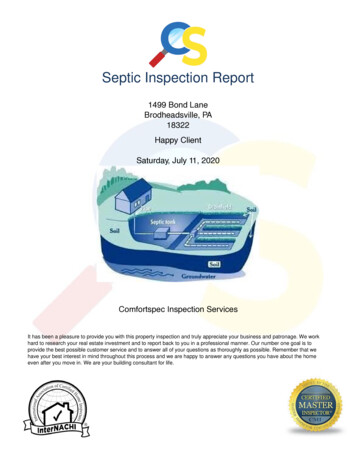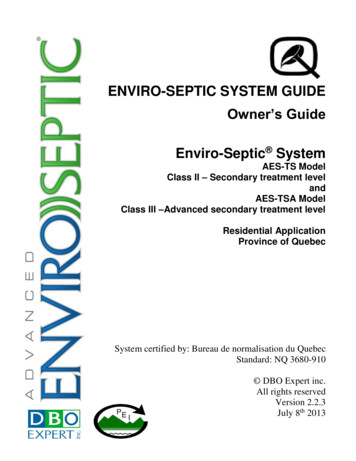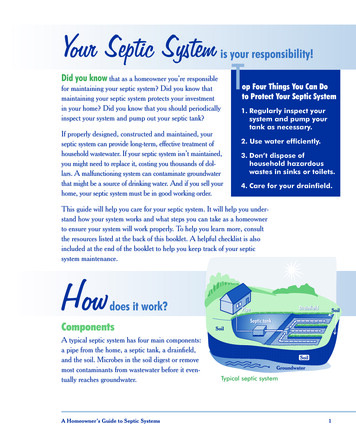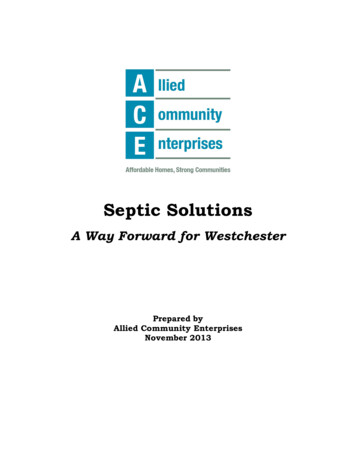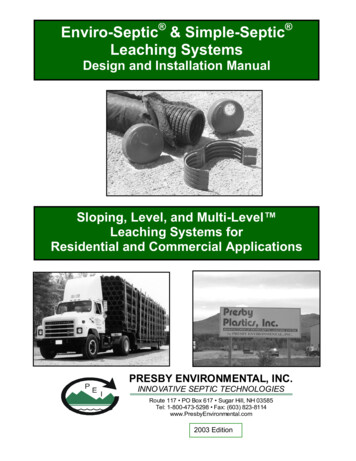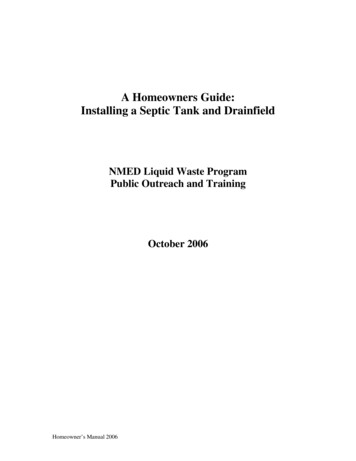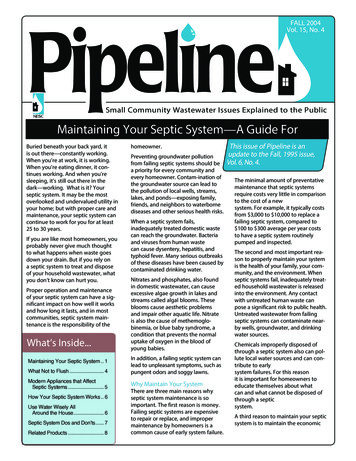
Transcription
FALL 2004Vol. 15, No. 4Small Community Wastewater Issues Explained to the PublicMaintaining Your Septic System—A Guide ForBuried beneath your back yard, itis out there—constantly working.When you’re at work, it is working.When you’re eating dinner, it continues working. And when you’resleeping, it’s still out there in thedark—working. What is it? Yourseptic system. It may be the mostoverlooked and undervalued utility inyour home; but with proper care andmaintenance, your septic system cancontinue to work for you for at least25 to 30 years.If you are like most homeowners, youprobably never give much thoughtto what happens when waste goesdown your drain. But if you rely ona septic system to treat and disposeof your household wastewater, whatyou don’t know can hurt you.Proper operation and maintenanceof your septic system can have a significant impact on how well it worksand how long it lasts, and in mostcommunities, septic system maintenance is the responsibility of theWhat’s Inside.Maintaining Your Septic System. 1What Not to Flush. 4Modern Appliances that AffectSeptic Systems. 5How Your Septic System Works. 6Use Water Wisely AllAround the House. 6Septic System Dos and Don’ts. 7Related Products. 8homeowner.Preventing groundwater pollutionfrom failing septic systems should bea priority for every community andevery homeowner. Contam-ination ofthe groundwater source can lead tothe pollution of local wells, streams,lakes, and ponds—exposing family,friends, and neighbors to waterbornediseases and other serious health risks.When a septic system fails,inadequately treated domestic wastecan reach the groundwater. Bacteriaand viruses from human wastecan cause dysentery, hepatitis, andtyphoid fever. Many serious outbreaksof these diseases have been caused bycontaminated drinking water.Nitrates and phosphates, also foundin domestic wastewater, can causeexcessive algae growth in lakes andstreams called algal blooms. Theseblooms cause aesthetic problemsand impair other aquatic life. Nitrateis also the cause of methemoglobinemia, or blue baby syndrome, acondition that prevents the normaluptake of oxygen in the blood ofyoung babies.In addition, a failing septic system canlead to unpleasant symptoms, such aspungent odors and soggy lawns.Why Maintain Your SystemThere are three main reasons whyseptic system maintenance is soimportant. The first reason is money.Failing septic systems are expensiveto repair or replace, and impropermaintenance by homeowners is acommon cause of early system failure .This issue of Pipeline is anupdate to the Fall, 1995 issue,Vol. 6, No. 4.The minimal amount of preventativemaintenance that septic systemsrequire costs very little in comparisonto the cost of a newsystem. For example, it typically costsfrom 3,000 to 10,000 to replace afailing septic system, compared to 100 to 300 average per year coststo have a septic system routinelypumped and inspected.The second and most important reason to properly maintain your systemis the health of your family, your community, and the environment. Whenseptic systems fail, inadequately treated household wastewater is releasedinto the environment. Any contactwith untreated human waste canpose a significant risk to public health.Untreated wastewater from failingseptic systems can contaminate nearby wells, groundwater, and drinkingwater sources.Chemicals improperly disposed ofthrough a septic system also can pollute local water sources and can contribute to earlysystem failures. For this reasonit is important for homeowners toeducate themselves about whatcan and what cannot be disposed ofthrough a septicsystem.A third reason to maintain your septicsystem is to maintain the economic
Maintenancehealth of your community. Failingseptic systems can cause propertyvalues to decline. Sometimes buildingpermits cannot be issued for theseproperties. Also, failingseptic systems may contribute tothe pollution of local rivers, lakes,and shoreline that your communityuses for commercial or recreationalactivities.How to Maintain Your SystemSeptic system maintenance is oftencompared to automobile maintenance because only alittle effort on a regular basiscan save a lot of money andsignificantly prolong the lifeof the system.Annual inspections of yourseptic system are recommended toensure that it is working properly andto determine when the septic tankWater Use Around The Home45% Toilets30% BathingLaundry & Dishes 20%Drinking & Cooking 5%should be pumped. Systems thathave moving parts may require morefrequent inspections. By having yoursystem inspected and pumped regularly, you can prevent the high cost ofseptic system failure.A professional contractor can do athorough inspection of the entire system and check for cracked pipes andthe condition of the tees or bafflesand other parts of the system.A thorough septic system inspectionwill include the following steps:Pipeline is published quarterly by theNational Environmental Services Centerat West Virginia University,P.O. Box 6064, Morgantown, WV 26506-6064Pipeline is funded through a grant from theU.S. Environmental Protection AgencyWashington, D.C.Steve Hogye—Project OfficerMunicipal Support DivisionOffice of Wastewater ManagementNational Small Flows ClearinghouseWest Virginia University, Morgantown, WVRick Phalunas — IEDMarilyn Noah — EditorJennifer Hause — Technical AdvisorEd Winant PE — Technical AdvisorJohn Fekete — Senior Graphic DesignerJamie Bouquot — Graphic DesignerPermission to quote from or reproduce articles inthis publication is granted when due acknowledgement is given.Please send a copy of the publication in which informationwas used to the Pipeline editor at the address above.an equal opportunity/affirmative action institutionISSN 1060-0043The contents of this newsletter do not necessarily reflect the views and policies ofthe U.S. Environmental Protection Agency, nor does the mention of trade namesor commercial products constitute endorsement or recommendation for use.Printed on recycled paper1. Locating the system.Even a professional may have troublelocating the system if the access toyour tank is buried. One way to startlooking is to go in the basement anddetermine the direction the sewerpipe goes out through the wall. Backoutside, the inspector will use aninsulated probe inserted into the soilto locate the buried piping. Once thesystem components are found, besure to sketch a map and keep it onhand to save time on future servicevisits.2. Uncovering the manhole andinspection ports.This may require some digging in theyard. If they are buried, it will helpfuture inspections ifelevated access covers or risers areinstalled to make it easier to accessthe ports and manhole.3. Checking connections.Flushing the toilets, running waterin the sinks, running the washingmachine through a cycle will help todetermine if the household plumbingis all going to thesystem and working correctly.4. Measuring the scum andsludge layers.The inspector will measure the scumand sludge layers with special toolsinserted through the inspection port.A proper inspection will also includea visual observation of the scum andsludge layers. (The sludge layer is theheavier solids that have settled downto the bottom of the tank. The scumlayer is made up of grease and lightsolids that float near the top of thetank.)If the sludge depth is equal to onethird or more of the liquid depth, thetank should be pumped. Also, thetank needs to be pumped when it is1/3 full. See the table below for estimated pumping frequencies. But beaware it is most prudent to conductregular inspections and pump whenthe inspection says the tank needs tobe pumped.Remember that toxic gases are produced by the natural treatment processes in septic tanks and can kill inminutes. Even looking into the tankcan bedangerous. Leave inspections to thetrained professionals.5. Checking the tank and thedrainfield.The inspector will check thecondition of the baffles or tees, the2PIPELINE – Fall 2004; Vol.15, No. 4National Environmental Services Center (800) 624-8301 or (304) 293-4191
Maintenancewalls of the tank for cracks, and thedrainfield for any signs of failure. Ifthe system includes a distributionbox, drop box, or pump, these needto bechecked too.How often the tank needs to bepumped depends on the tank size,the number of people living in yourhome, and the habits of your particular household. Garbage disposals andhigh-water-use appliances, such as ahot tub or whirlpool, also affect thepumping frequency.tact your local health department orpermitting agency for assistance.can get a more accurate idea of howoften it should be pumped.It’s a good idea to be present whenyour tank is being pumped. Makesure that the contractor uses themanhole, not the inspection ports,to pump the tank to avoid damagingthe baffles or tees. Also make sure allof the material in the tank is removed.It is not necessary to leave anythingin the tank to “restart” the biologicalprocesses, but it is also not necessaryto scrub or disinfect the tank.Protect the tank and drainfieldPumping your septic tank is probablythe single most important thing thatyou can do to protect your system.If the buildup of solids in the tankbecomes too high and solids moveto the drainfield, this could clog andstrain the system to the point where anew drainfield will be needed.When it’s time to pump, be sure tohire a licensed contractor. He or shewill have the appropriate equipmentand will dispose of the sludge at anapproved treatment site. You canfind listings for licensed pumpers andhaulers in the yellow pages, or con-RecordkeepingFigure 1.Estimated septic tank pumping frequencies inyears. These figures assume there is no garbagedisposal unit in use. If one is in use, pumpingfrequency may need to be increased.(Source: Pennsylvania State University Cooperative Extension Service.)Household Size(number of .55.94.8PIPELINE – Fall 2004; Vol.15, No. 4It is very important tokeep a detailed recordof all inspections,pumpings, permits,repairs, and any othermaintenance to yoursystem along with asketch of where yourseptic system islocated. Having thisinformation on handfor service visits cansave you both time andmoney.Protect your septic system frompotential damage. Don’t plant anything but grass near your septicsystem—roots from shrubs andtrees can cause damage—and don’tallow anyone to drive or operateheavy machinery over any part of thesystem. Also, don’t build anythingover the drainfield. Grass is the mostappropriate cover for thedrainfield.Sound septic system operationand maintenance practices includeconserving water, being carefulthat nothing harmful is disposedof through the system, and havingthe system inspected annually andpumped regularly.By educating everyone in your household about what is and what isn’tgood for septic systems, they canbegin to develop good maintenancehabits.Learn the location ofyourseptic system, and keepa diagram or sketch ofit with your maintenance records.Inspecting your septicsystem annually is agood way tomonitor your system‘shealth. Inspections canreveal problems beforethey become serious,and by checking thelevels of sludge andscum in your tank, you3National Environmental Services Center (800) 624-8301 or (304) 293-4191
MaintenanceWhat Not To FlushWhat you put into your septic system greatly affects its ability to do itsjob. Remember, your septic systemcontains living organisms that digestand treat waste. As a general rule ofthumb, do not dispose ofanything in your septic system thatcan just as easily be put in the trash.Your system is not designed to be agarbage can and solids build up inthe septic tank that will eventuallyneed to be pumped. The more solidsthat go into the tank, the morefrequently the tank will need to bepumped, and the higher the risk forproblems to arise.In the kitchen, avoid washing foodscraps, coffee grinds, and other fooditems down the drain. Grease andcooking oils contribute to the layer ofscum in the tank and also should notbe put down the drain.The same common-sense approachused in the kitchen should be usedin the bathroom. Don’t use the toiletto dispose of plastics, paper towels, facial tissues, tampons, sanitarynapkins, cigarette butts, dental floss,disposablediapers, condoms, kitty litter, etc. Theonly things that should be flusheddown the toilet are wastewater andtoilet paper.When used as recommended bythe manufacturer, most householdcleaning products will not adverselyaffect the operation of your septictank. Drain cleaners are an exception,however, and only a small amount ofthese products can kill the bacteriaand temporarily disrupt the operationof the tank.Household cleaners such as bleach,disinfectants, and drain and toiletbowl cleaners should be used inmoderation and only in accordancewith product labels. Overuse of theseproducts can harm your system. Itmakes sense to try to keep all toxicand hazardous chemicals out of yourseptic tank system.To avoid disrupting or permanentlydamaging your septic system, do notuse it todispose ofhazardous household chemicals.Even small amountsof paints, varnishes, paint thinners,waste oil, antifreeze, photographic solutions,pharmaceuticals, antibacterial soaps,gasoline, oil,pesticides, andother organicchemicals can destroyhelpful bacteria and the biological digestion taking placewithin your system. Thesechemicals also pollute thegroundwater.several layers of newspaper beforerinsing.To help prevent groundwaterpollution, be sure to dispose of leftover hazardous chemicals by takingthem to an approvedhazardous waste collectioncenter. For more information, contactyour local healthdepartment.Additives/System CleanersWhile many products on the marketclaim to help septicsystems work better, the truth is thereis no magic potion to cure an ailingsystem. In fact, most engineers andsanitation professionals believe thatcommercial septic system additivesare, at best, useless, and at worst,harmful to a system.There are two types of septicsystem additives: biological (likebacteria, enzymes, and yeast) andchemical. The biological additives areharmless but some chemical additivescan potentially harm the soil in thedrainfield andcontaminate the groundwater.While there hasn’t been extensivestudy on the effectivenessof these products, the general consensus among septic system expertsis that septic systemadditives are an unnecessary evil.Be aware that the extended use ofstrong pharmaceuticals and personalcare products may harm the workingbacteria population in the tank. Thetotal effects are unknown at this time.Even latex paint is unhealthyfor your septic system. Toreduce the cleanup of theseproducts, squeeze all excesspaint and stain from brushesand rollers on4PIPELINE – Fall 2004; Vol.15, No. 4National Environmental Services Center (800) 624-8301 or (304) 293-4191
MaintenanceModern Appliances May Affect Your Septic TankHot Tubs/WhirlpoolsHot tubs and whirlpools have becomemore common today in the home asa source of relaxation and therapy.While the soothing, swirling waters ofa spa may be good for a homeowner,unfortunately, the large amounts ofwater that drain from the hot tub arenot good for your septic system.Emptying large quantities of waterfrom a hot tub into your septic system can overload asystem and stir the solids in the tank,pushing them into the drainfield,eventually causing it to fail.amount of solids in the tank up to50 percent and should not be used.Eliminating a garbage disposal cangreatly reduce the amount of greaseand solids that enter the drainfield.Because a garbage disposal grindskitchen scraps into small pieces,once they reach the septic tank, theyare suspended in the water. Someof these materials are broken downby bacterial action, but most of thegrindings must be pumped out of thetank.Hot tub water should instead becooled and then drained onto turf orlandscaped areas of your property wellaway from the septic tank, drainfield,and house in accordance with localregulations.As a result, use of a garbagedisposal will significantly increase theamount of sludge and scum in yourseptic tank. Therefore, many statesrequire a larger minimum size septictank if there will be a garbage grinder/disposal unit in operation in thehouse.Garbage DisposalsWater SoftenersGarbage disposals can increase theneedlessly pump hundreds ofgallons of water into the septic system all at once. This can agitate thesolids and allow excess to flow intothe drainfield. Consult a plumbingprofessional about alternative routingfor suchfreshwater treatment systems.Water softeners remove hardnessby using a salt to initiate an ionexchange. The backwash to regenerate the softener flushes pounds ofthis used salt into the septic system.There is some concern that theseexcess salts can affect the digestion inthe septic tank or reduce the permeability in the soil dispersal system.The Winter 2001 issue of Pipelinegives additional information aboutwater softener use.Some freshwater purificationsystems, including water softeners,PIPELINE – Fall 2004; Vol.15, No. 4National Environmental Services Center (800) 624-8301 or (304) 293-41915
MaintenanceHow Your Septic System WorksThere are two main parts to the basicseptic system: the septic tank and thedrainfield.Household wastewater first flows intothe septic tank where it should stayfor at least a day. In the tank, heavysolids in the wastewater settle to thebottom forming a layer of sludge, andgrease and light solids float to the topforming a layer of scum.The sludge and scum remain in thetank where naturally occurring bacteria work to break them down. Thebacteria cannot completely breakdown all of the sludge and scum,however, and this is why septic tanksneed to be pumped periodically.The separated wastewater in themiddle layer of the tank is pushed outinto the drainfield as more wastewater enters the septic tank from thehouse. If too much water is flushedinto the septic tank in a short periodof time, the wastewater flows out ofthe tank before it has had time toseparate. This can happen on dayswhen water use is unusually high, ormore often if the septic tank is toosmall for the needs of the household.Homeowners should stagger theirlaundry throughout the week and tryto do no more than two wash loadsper day.When wastewater leaves a septic tanktoo soon, solids can be carried with itto the drainfield. Drainfields provideadditional treatment for the wastewater by allowing it to trickle from aseries of perforated pipes, through alayer of gravel, and down through thesoil. The soil acts as a natural filter andcontains organisms that help treatthe waste. Solids damage the drainfield by clogging the small holes inthe drainfield pipes, and excess waterstrains the system unnecessarily.Conventional septic systems are avery simple way to treat householdwastewater. They contain no moving parts and are easy to operateand maintain. Although homeowners must take a more active role inmaintaining septic systems, oncethey learn how their systems work,it is easy for them to appreciate theimportance of a few sound operationand maintenance practices.Use Water Wisely AllAround The HouseWater conservation is very importantfor septic systems because continualsaturation of the soil in the drainfieldcan affect the quality of the soil andits ability to naturally remove toxics,bacteria, viruses, and other pollutantsfrom the wastewater.The most effective way to conservewater around the house is to firsttake stock of how it is being wasted.Immediately repair any leaking faucets or running toilets, and use dishwashers only when full.LaundryYou can also cut down on water useby selecting the proper load sizefor your washing machine. Washingsmall loads of laundry with largequantities of water is a waste of bothwater and energy.Also doing laundry all in one daymight seem like a good use of time,but it could be harmful to your septicsystem. By doing several loads in succession, the septic system does nothave time to adequately treat wastes.You might be hydraulically overloading your septic system, causing it topass solids into the drainfield.Newer energy-efficient clothes washers use 35 percent less energy and 50percent less water than a standardmodel. Look for appliances that display theEnergy Star symbol. Thisindicates they meet strictenergy efficiency guidelines set by the EPA andthe U.S. Department of Energy.6PIPELINE – Fall 2004; Vol.15, No. 4Use only nonphosphate or low phosphate laundry detergents. PowderNational Environmental Services Center (800) 624-8301 or (304) 293-4191
Maintenancedetergents with low inert (clay)content are also easier on the septicsystem.BathroomsIn a typical household, most of thewater used indoors is usedin the bathroom, and there are several little things that can be done toconserve water there.For example, try to avoid lettingwater run while washing hands andbrushing teeth. Avoid taking longshowers and install water-saving features in faucets and shower heads.These devices can reduce water useby up to 50 percent. Low-flush toiletsuse 1.6gallons per flush compared to thethree to five gallons used by conventional toilets. Even using a toiletdam or putting a container filled withrocks in the toilettank can reduce water use by25 percent.It is also important to avoid overtaxing your system by using a lot ofwater in a short time period, or byallowing too much outside water toreach the drainfield. Try to space outactivities requiring heavy water useover several days. Also, divert roofdrains,surface water, and sump pumps awayfrom the drainfield.Septic System Dos and Don’ts*Do learn the location of your septictank and drainfield. Keepa sketch of it handy with your maintenance record for service visits.*Don’t plant anything over or nearthe drainfield except grass. Rootsfrom nearby trees or shrubs may clogand damage the drain lines.*Do have your septic system inspected annually.*Don’t dig in your drainfield or buildanything over it, and don’t cover thedrainfield with a hard surface such asconcrete or asphalt. The area over thedrainfield should have only a grasscover. The grass will not onlyprevent erosion, but will help removeexcess water.*Do have your septic tank pumpedout by a licensed contractor, approximately every three to five years, oras often as is appropriate for yoursystem*Do keep your septic tank coveraccessible for inspections and pumping. Install risers if necessary.*Do call a professional wheneveryou experience problems with yoursystem, or if there are any signs ofsystem failure.*Do keep a detailed record of repairs,pumping, inspections, permits issued,and other maintenance activities.*Do conserve water to avoid overloading the system. Be sure to repairany leaky faucetsor toilets.*Do divert other sources of water,like roof drains, house footing drains,and sump pumps, away from theseptic system. Excessive water keepsthe soilin the drainfield from naturally cleansing the wastewater.*Don’t go down into a septic tank.Toxic gases are produced by thenatural treatment processes in septictanks and can kill in minutes. Extremecare should be taken when inspectinga septic tank, even when just lookingin.*Don’t make or allow repairs to yourseptic system without obtaining therequired health department permit.Use professional licensed onsite contractors when needed.*Don’t use septic tank additives.Under normal operating conditions,these products usually do not helpand some may even be harmful toyour system.*Don’t use your toilet as a trash canor poison your septic system and thegroundwater by pouring harmfulchemicals and cleansers down thedrain. Harsh chemicals can kill thebeneficial bacteria that treat yourwastewater.*Don’t use a garbage disposal without checking with your local regulatory agency to make sure that yourseptic system can accommodate thisadditional waste.*Don’t allow backwash from homewater softeners to enter the septicsystem.*Don’t allow anyone to drive or parkover any part of the system.The Summer 2004 issue of Pipeline provides more information about septic tanks for homeowners.National Environmental Services Center (800) 624-8301 or (304) 293-41917
septic system is located. Having this information on hand for service visits can save you both time and money. Learn the location of your septic system, and keep a diagram or sketch of it with your mainte-nance records. Inspecting your septic system annually is a good way to monitor your system's health. Inspections can reveal problems before


